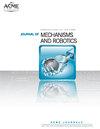利用行波在床面上进行多方向病人转移的设计指南
IF 3.2
4区 计算机科学
Q2 ENGINEERING, MECHANICAL
Journal of Mechanisms and Robotics-Transactions of the Asme
Pub Date : 2023-10-16
DOI:10.1115/1.4063573
引用次数: 0
摘要
身体运动能力有限的患者需要护理人员的帮助,经常重新定位和转移。这些常见的手工任务对护理人员来说是体力消耗很大的。为了尽量减少照顾者的体力劳动,已经提出了几种辅助装置。然而,大多数设备设计复杂,价格昂贵,只能使患者向一个方向移动,或者仍然需要护理人员的干预。这项研究的灵感来自于可以携带物体的自然波,如水波,该研究提出了一种与执行器无关的设计准则,可以使用行波作为替代解决方案,在床表面上移动身体。具体而言,本研究探讨了传输速度和运动平稳性如何受到波浪参数的影响,如波长、波幅、用于创建波浪剖面的致动器数量及其运动模式。对于移动弹性物体(如人体),还建立了额外的要求,以最小化身体和波粒子之间的界面层的刚度。结果表明,输送速度与波频和波致动器的水平位移成线性关系。最大限度地增加执行器的数量,同时尽量减少波幅和波长,将增加平滑度。同时,波长必须至少是物体长度的一半,以保证运动的稳定性,同时也要超过一个临界值,以保证在实际中得到可行的波。此外,波长、波幅和致动器的数量将决定界面层所需的最小刚度。本文章由计算机程序翻译,如有差异,请以英文原文为准。
Towards Design Guidelines for Multidirectional Patient Transfer on a Bed Surface Using Traveling Waves
Patients who have limited body movement ability need assistance with frequent repositioning and transfers from their caregivers. These common manual tasks are physically strenuous for caregivers. To minimize caregiver physical effort, several assistive devices have been proposed. However, most devices have complex designs, are expensive, can only move the patient in one direction, or still need the caregiver's intervention. Inspired by natural waves such as water waves that can carry objects, this study presents actuator-agnostic design guidelines for moving a body on a bed surface using traveling waves as an alternative solution. Specifically, this study explores how transportation speed and movement smoothness are affected by wave parameters such as the wavelength, wave amplitude, number of the actuators used to create the wave profile, and their movement pattern. Additional requirements for moving an elastic object, such as a human body, were also established to minimize the stiffness of the interface layer between the body and wave particles. Results suggest that transportation speed is linearly proportional to wave frequency and horizontal displacement of the wave actuators. Maximizing the number of actuators while minimizing wave amplitude and wavelength will increase the smoothness. Meanwhile, the wavelength must be at least half of the object length to ensure motion stability while also exceeding a critical value to guarantee that feasible waves are achieved in practice. Additionally, the wavelength, wave amplitude, and number of actuators will determine the minimum required stiffness of the interface layer.
求助全文
通过发布文献求助,成功后即可免费获取论文全文。
去求助
来源期刊

Journal of Mechanisms and Robotics-Transactions of the Asme
ENGINEERING, MECHANICAL-ROBOTICS
CiteScore
5.60
自引率
15.40%
发文量
131
审稿时长
4.5 months
期刊介绍:
Fundamental theory, algorithms, design, manufacture, and experimental validation for mechanisms and robots; Theoretical and applied kinematics; Mechanism synthesis and design; Analysis and design of robot manipulators, hands and legs, soft robotics, compliant mechanisms, origami and folded robots, printed robots, and haptic devices; Novel fabrication; Actuation and control techniques for mechanisms and robotics; Bio-inspired approaches to mechanism and robot design; Mechanics and design of micro- and nano-scale devices.
 求助内容:
求助内容: 应助结果提醒方式:
应助结果提醒方式:


